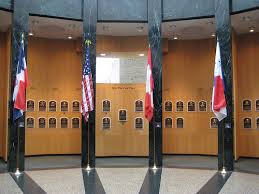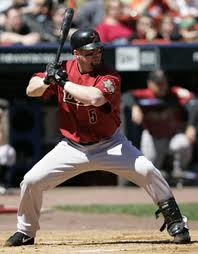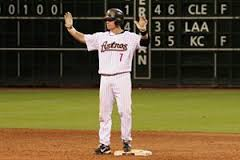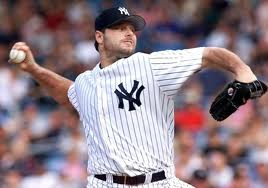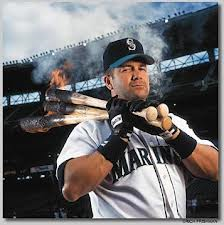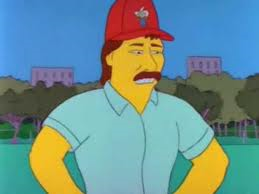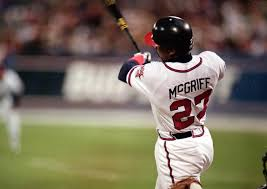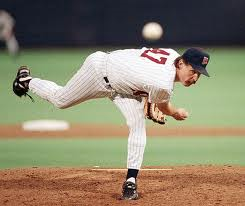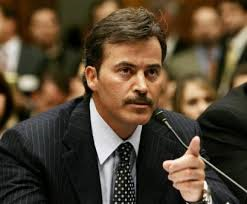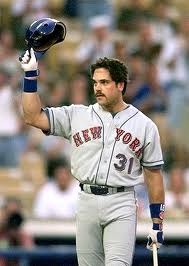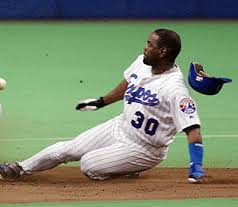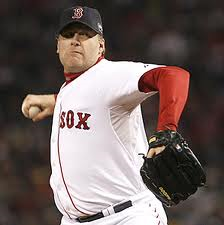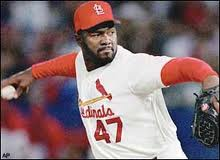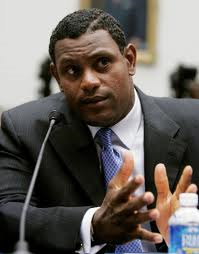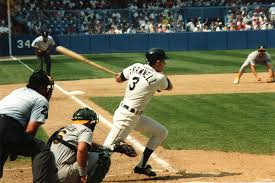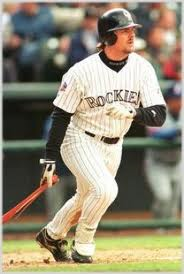It’s time for that annual holiday tradition (well, winter months-esque tradition, though I’m finding that this week is surprisingly suited towards writing a 3-part, 10,000 word diatribe on the Baseball Hall of Fame) wherein I take 36 famous baseball players and render them for your observing pleasure. This year’s ballot is, as was predicted, even more crammed full than last year’s ballot, and equally full of uncertainty regarding its outcome (except for one case, which I’ll get to in Part II). Nobody has any real clue of what’s about to happen, although I’m sure if Nate Silver were feeling bored, he could accurately predict who’s making it in and who will be left out in the cold. Then again, he’s got better things to do – like politics.
Last year’s Hall of Fame ballot was particularly notable for not electing a single person to the hallowed shrine of America’s pastime – except for three dead men, one of whom actively campaigned to keep blacks and other minorities from the game. This year will be different – if only because Joe Torre, Tony LaRussa, and Bobby Cox will be inducted following their unanimous election on the Veteran’s Committee ballot. (More on that in Part III) What remains a question, however, is which players will be standing up there with them when the summer rolls along.
For that, I present to you this guide to the 36 players who will be on the ballot this year. For the ease of reading – and to ease the suffering on my fingers – I’ll be alternately keeping this short and breaking this into 3 separate articles, to be published over the course of the week. Part 1 comes out today, with Part 2 coming on Tuesday, and Part 3 coming Friday afternoon (with a two day split for Christmas and Boxing Day – I’m sure the Recorder is big in Alberta, after all). Part 2 will deal with the ballot newcomers, whilst Part 3 will wrap up everything I’ve covered, reveal my IBWAA (Internet Baseball Writers Association of America) ballot – yes, I actually voted for the Hall of Fame this year, but not in any official capacity! – and talk about what I think will actually happen when the vote tally’s are released in January. For now, enjoy Part I – the Holdovers from Ballots Prior.
(I just now picked up on the Ghosts of Christmas Past, Present, and Future theme – and will be running with this motif intermittently for the rest of the column. You’re welcome.)
GHOSTS OF BALLOTS PAST
Jeff Bagwell – Years on Ballot: 4 – Vote Percentage: 59.6%
Bagwell gained nearly 4% in his vote total last year, which was impressive, but not a feat that I think will be matched again this year – this ballot is simply too deep, and he’ll suffer for it. Which is unfortunate, because the more that one reflects upon the 1990’s through early 2000’s – aka, the Steroid Era – the higher the light into which Bagwell is cast. In terms of counting stats, Bagwell pales in comparison to Frank Thomas, but not as much as one might think – only 70+ home runs separate them. In addition, Thomas’s career was boosted by his only playing 1B for effectively half of his career, while Bagwell languished in the Astrodome, a park that probably cost him at least 30+ home runs over his career. Advanced statistics actually rank Bagwell higher than the Big Hurt, with the Killer B’s member posting a WAR/WAR7/JAWS of 79.5/48.2/63.8 compared to Thomas’s 73.6/45.3/59.5.
(WAR stands for Wins Above Replacement, and signifies how many wins a player was worth above a regular schlub pulled in off the street (or a replacement player). To wit, 2.0 WAR means that you held your own, and didn’t hurt your team any. 3.0 is an above-average player. 5.0 means you’ve had an All-Star season. 7.0 means you should be considered as an MVP candidate. 10.0 means you’ve broken advanced statistics. These are counted cumulatively for a player’s career – typically, 65 is about where true Hall of Fame consideration starts.
WAR7 is the sum of the best 7 WAR seasons for a player, as opposed to a cumulative total. They help to represent a player’s peak. This will be especially interesting when discussing Nomar Garciaparra next year, who only managed a total career WAR of 44.2, but had a peak of 43.0. Work that out in your mind for a second.
JAWS is a system designed by Jay Jaffe, advanced stat god, to average a player’s WAR for their career and their WAR7 to better allow for comparison to Hall of Famers by position. This is useful because we’re dealing exclusively with the Hall of Fame here, and need all the tools we can get to better tear down these players who did nothing other than play baseball and take drugs.)
The biggest hurt for Bagwell (other than the Big Hurt – and you’re welcome, by the way. I could have saved that joke until Frank Thomas came up in Part 2, but now it’s out of the way. Waste of a terrible joke) is the continued whisper regarding PEDs, even though he took what was legal at the time he played, and never tried to hide anything, and even though he was an outstanding citizen to the community of Houston, etc. Basically, a small segment of the writers who vote upon the ballot don’t want Bagwell in their Hall of Fame, though that margin is shrinking every year. It might take three more years, though, for Bagwell to receive his due. Verdict: Should be in, but won’t happen this year.
Craig Biggio – Years on Ballot: 2 – Vote Percentage: 68.2%
Of all the returning candidates, Biggio has the best chance of making it in this year, as he fell about 39 votes short last year. Given his stats and general popularity, this is again a question of when and not if he’ll make it in. Unfortunately, in the glut of candidates that has emerged this year, Biggio might be one to suffer because of the lack of pizazz of his case (yes, he had 3,000 hits, but Frank Thomas has 500 home runs, and Tom Glavine 300 wins, and people love 500 homers more than 3,000 hits unless you’re Derek Jeter, in which case, YANKEE YANKEE YANKEE). There’s no question that Biggio has earned this – he’s the only player with 600 doubles, 275 HR, 2,700 hits, and 400+ stolen bases, to say nothing of reaching 3,000 hits and some similar total in being hit-by-pitches.
The problem here for Biggio is the fact that writers can only vote for 10 players at a time. This isn’t normally a problem, and is a good way to spread around the love. However, when a glut of candidates – as the Steroid Era has given us – emerges, those 10 votes get spread a little more thin than normal, and quality players suffer for it. Those 39 votes, which might have come this year, may go to a writer who thinks that Mike Mussina or Mike Piazza were more deserving, or that Tim Raines really did have a better career after all, or to someone who doesn’t want Sammy Sosa to fall off the ballot (you know, because they’re fascist). When looking at everything in this light, one sees exactly how hard it is for ANYBODY to get into the Hall of Fame, as compared to the NFL, where 44 writers argue for a bit and then vote on people, with the top 5 candidates gaining enshrinement.
If the top 5 candidates here were enshrined, the Hall would be infinitely more crowded. Then again, poor guys like Biggio might not have to wait so long. Verdict: Possible, but unlikely for enshrinement, though he deserves it for sure.
Barry Lamar Bonds
Ah, this guy.
To his credit, 206 writers felt compelled enough to vote for him last year, in spite of his being the human equivalent of a skunk that’s been rotting on the side of the road for two weeks in terms of personality and popularity amongst the media. Oh, and that whole steroids thing he might have done/probably did/if you don’t think he did then you’re due for a long sad life where people will perpetually take advantage of you.
He’s not getting in this year. That’s not to say he won’t in the future – his stats overwhelm the mind, and you don’t hit the way he did solely because of PEDs. It takes supernatural ability to perform what he did, to the extents that he did.
Remember when I said a WAR of 65 was essentially the eye test of a Hall of Famer?
Bonds WAR is 162.5.
I truly believe that he will get in someday, whether on his 10th ballot or in a Veteran’s Committee that is set up to rectify the collective damage of the Steroid Era. Until then, however, he’ll (at most) incrementally increase his vote percentage to the low 40’s. Verdict: Now is not the time.
Roger Clemens – Years on Ballot: 2 – Vote Percentage: 37.6%
See above description, except throw in that Clemens is, if possible, a bigger douche. Doesn’t mean he shouldn’t be in, however. Just that he’s made things difficult for himself. Verdict: Now is not the time.
Edgar Martinez – Years on Ballot: 5 – Vote Percentage: 35.9%
It doesn’t bode well for your candidacy when Roger Clemens and Barry Bonds, two of the most vilified candidates EVER, have higher percentages than you do. Poor Edgar Martinez, who was one of the greatest pure hitters of his time. The damn DH rule is what’s keeping him from advancing any further, in addition to a lack of meaningful postseason experience or some kind of heavy counting stats. Edgar is the type of player who needs to have a surge sometime in the next two or three years in order to have any real chance of making the Hall of Fame, or else he’ll be doomed to Dale Murphy territory, falling off in years to come. This year is not the year for his surge – there’s too many other deserving candidates for that to happen. In the end, he’ll probably float up to 38%, but no higher. Verdict: Nope.
Don Mattingly – Years on Ballot: 14 – Vote Percentage: 13.2%
In the years I’ve been obsessively following the voting on the Hall of Fame, I’ve come to appreciate several things. Namely, the yearly agonizing wait that several candidates go through, wherein they sit by the phone, waiting for a call that they’re never sure they’re going to receive. This is where players like Jack Morris have it the worst, with no real idea of what is about to happen from year to year. On the other hand, you have players like my beloved David Concepcion, who routinely receive their 15%, never changing from year to year, before falling off the ballot after their 15 year purgatory. One might argue that the lack of tension makes this cross somewhat easier to bear than dreading whether the phone is going to ring or not – and they’d be right. On the other hand, having to be reminded that only 12% of the BBWAA thinks that you’re deserving of enshrinement (which means that 88% think you don’t belong) for fifteen years straight has to suck at some point.
Thus, I propose the “Mercy Killing”. If you aren’t above, say 20% by your 10th year – a point which nobody has overcome on any ballot prior – you’re removed from the Writer’s Ballot and shifted to the Veteran’s Committee. This total can climb by 5% each year, so that if you haven’t reached 25% by your 11th year, 30% by your 12th year, 35% by your 13th, and 40% by your 14th, you’re off. (The 15th year is irrelevant; also, I’m open to negotiation on the rising percentages.) This would have saved poor Davey Concepcion 5 years of heartbreak – he truly wanted to be in the Hall, and each subsequent year he didn’t make it in was torturous, and would remove guys like Don Mattingly from having to do this year in and year out. He’s not making it in this year, or next. Verdict: Nope.
Fred McGriff – Years on Ballot: 5 – Vote Percentage: 20.7%
Crime Dog!
McGriff seems destined to ride the bottom of the ballot in perpetuity, continually coasting along until he reaches my “Mercy Rule” or somehow a perception in how we view the Steroid Era shifts to reflect the consistently good, unaided by performance enhancing drugs, players are voted in. Until that time, however, there is no room for the Crime Dog, 493 homers be damned. (What, NOBODY wanted to sign him so he could hit 7 more home runs? NOBODY?! One of the great baseball injustices of my life.) Verdict: He’ll always be in the Hall in my heart…but not here.
Mark McGwire – Years on Ballot: 8 – Vote Percentage: 16.9%
McGwire is actually one of several candidates to lose votes during last year’s election. He, along with seven other players, lost anywhere between 0.6% and a whopping 4.6% of their votes between 2012 and 2013; only Jack Morris, Bagwell, and Tim Raines gained votes. What does this mean? Well, year to year fluctuations can be expected, but it could also mean that several dozens of writers were far less sold on several candidates than they’d been a year ago – Mark McGwire and Rafael Palmeiro losing votes could reflect a popular trend of thinking in the Steroid Era. However, for candidates like Lee Smith, the total should be moving in the opposite direction – but more on him later. What this means is that McGwire isn’t getting in on this ballot – or any ballot. He needs to fall off for that Veteran’s Committee subgroup that comes along to deal with players like him, Palmeiro, Sosa, and potentially Andy Pettitte, who might need an extra bit of thinking on who’s deserving…and who’s just a schmuck. Which is again unfortunate, because Mark McGwire hit home runs at a more prodigious rate than most players to have ever played the game – what doesn’t help his Hall case is the fact that hitting home runs is just about the only thing he did well. Verdict: Nope.
Jack Morris – Years on Ballot: 15 – Vote Percentage: 67.7%
In a year where Morris needed to make a significant bump in his vote totals to the low 70’s percentile, he gained 1%. That’s roughly 6 people who decided he was worthy of being voted in. That isn’t much when you consider that he only needed 42 votes more to gain enshrinement, but is astronomical when you consider that he’s been on the ballot for 15 years, and those voters aren’t likely to change their minds anytime soon. If anything, they’re more convinced than ever that they must hold out against the man who, if elected, would have the highest ERA of any pitcher in the Hall of Fame. You’ll forgive me if I’m not holding out hope for Jack Morris, although there is technically a mathematical chance that he could make it.
If he does, it’s possibly a coup that the “greatest pitcher of the 80’s” makes it in with the “greatest pitcher of the 90’s”. If he doesn’t, there’s always the memory of Game 7 of the 1991 World Series, which was against the Braves, and will be all that Morris fans have to savor on the day when the losing manager from that World Series is elected into the Hall of Fame. Verdict: Not likely.
Rafael Palmeiro – Years on Ballot: 4 – Vote Percentage: 8.8%
Palmeiro needs to drop off the ballot sooner rather than later. One of the few of the steroid era to actually test positive, he lost 3.8% in his vote totals from 2012 to 2013. If that repeats itself, he’ll be out of the writer’s hands, his fate tossed to the scraps of the Veterans Committee for future deliberation. On an unrelated note, this guy comes off as an absolute heel (finger wagging while claiming “I never took steroids. Period.” in front of Congress followed by getting caught taking steroids will do that to you), and needs to be taken out of the public eye as soon as possible. It’s possible that several years in obscure purgatory will do some good for his image. Until then, I say thee nay. Verdict: No.
Mike Piazza – Years on Ballot: 2 – Vote Percentage: 57.8%
In years past, Piazza might have been a first ballot Hall of Famer. As it stands, he’ll probably follow the paths of players such as Gary Carter (8 ballots) and Carlton Fisk (2), neither of whom were elected on their first ballot in spite of being two of the greatest catchers of all time. Even Yogi Berra didn’t make it in on his first ballot, which reflects more the strict standards and utterly clueless deliberating done on the part of the writers rather than the quality of the candidates being elected. With that being said, I envision Piazza sticking around for 3 or more years, making incremental gains along the way, which is something of a travesty given that he’s unquestionably the greatest hitting catcher of all time and his defense was never quite as bad as it was made out to be. I mean, anything’s going to look bad when you compare it to something that you’re the best ever at. I may be the best operatic baritone ever, but it’s not going to matter much if I do it while tap-dancing terribly.
That came out better in my head. Verdict: Deserves it, but it won’t happen this year.
Tim Raines – Years on Ballot: 7 – Vote Percentage: 52.2%
To the delight of statheads such as Jonah Keri everywhere, Raines jumped above the hallowed 50% mark last year, a usual indication of inevitable induction. In fact, the only candidate to date who garnered 50% of the ballot without being eventually inducted is Gil Hodges, with Ron Santo getting called in by the Veterans Committee several years ago. (This also bodes well for Piazza, Bagwell, and Biggio, though potentially not so well for Morris and for someone we’ll get to in a few moments.) Raines’ case seems to be growing by the year, if you’ll be the judge of a popular accumulation of internet baseball knowledge. If Raines makes a big jump this year, I can see him making the ballot in 3 to 4 years.
(You’ll notice that I keep saying “might make it in 3-4 years”. I would just like to highlight that this is no accident, and there will be a massive callback to this in Part 3. Safe to say, the center cannot hold if this is the case.)
Raines was the greatest leadoff player of the 80s and 90s not named Rickey Henderson, and ranks 5th all time in stolen bases. In case you were wondering, yes, it is very difficult to steal a base, which makes the fact that his success percentage is higher than Henderson’s all the more intriguing. Raines deserved to go in long ago, and hopefully, the tide is shifting in his direction. Verdict: Not this year, but soon.
Curt Schilling – Years on Ballot: 2 – Vote Percentage: 38.8%
One of the greatest postseason pitchers of his era, and a controversial figure on and off the field, Schilling’s initial showing (above Roger Clemens) was something that, if this vote existed in a vacuum, nobody would have ever considered. With that being said, his potential is far from ironclad – he needs to make a major climb in his vote percentage this year if he wants to get in eventually. If not, he’s in for a long, Bert Blyleven-style climb to the 75% threshold. Large gains in vote totals aren’t unprecedented, but in a ballot this deep are highly unlikely – few writers actually follow through and vote for 10 players as they are allowed to do. In this instance, there are two ways that Schilling can make his gains: swiftly, in large, Larkin-esque climbs, or a few percentage points at a time. Either way, there are few certainties to his case beyond this: Verdict: Not this year.
Lee Smith – Years on Ballot: 12 – Vote Percentage: 47.8%
I love writing about baseball, but this is getting to be a bit of a slog. If anything, I’m getting deja vu about several of these players. Fortunately, I wrote a similar column last year! You can find it here! And here, for those players on here for their second ballot!
Lee Smith is stuck in limbo. Roughly 50% of the writers believe he should be in the Hall. Roughly 50% don’t. There is a thin line of plus-or-minus that we’re setting at about 3% because that’s nearly what his percentage fell by last year, down from 50.6% in what seemed like a positive trend at the time. To his credit, the one time holder of the most saves in baseball history no longer has both Trevor Hoffman and Mariano Rivera making his numbers look more and more insignificant by the day. On the other hand, they’ve done nothing to bolster his case either. It seems, more and more, that to be a relief pitcher in the Hall of Fame, you need to be:
A) A former lights-out starter – Dennis Eckersly
B) Heavily associated with World Champion teams – Rollie Fingers, Goose Gossage
C) Heavily associated with Facial Hair Galore! – Rollie Fingers, Goose Gossage
D) Invent/Perfect a New Type of Pitch and RIDE IT TO FLAT OUT DOMINATION – Bruce Sutter, Hoyt Wilhelm
E) Be the Greatest Ever At Your Job – (This is where you would have made a case for Lee Smith, except that, well, he wasn’t.)
You can slot John Smoltz into Category A, Trevor Hoffman and his change-up into Category D, and Mo Rivera into whichever one he wants, so long as he’s also in D (the cutter from hell) and E.
Lee Smith just doesn’t belong here, going by the Hall’s unofficial standards for relief pitchers. Maybe there’s a case for him in the Veterans Committee, but it seems more likely that he’ll be dropping off in several years rather than advancing his votes. Oh, yeah, he’s also the other guy who’s gotten 50% and is probably highly unlikely to get in. (He also played for both the Cardinals and Cubs, which HAS to be illegal in most civilized states) Verdict: Nope.
Sammy Sosa – Years on Ballot: 2 – Vote Percentage: 12.5%
Chuck Sosa into the Palmeiro bin and we’ll call it a day. Verdict: Nope.
Alan Trammell – Years on Ballot: 13 – Vote Percentage: 33.6%
Here’s where it gets hard to explain things. Trammell, for all intents and purposes, had nearly the same career that Barry Larkin did, minus the 30-30 HR/SB season, an MVP, and a few other counting stats. Yet Trammell continually languishes down at the bottom of the ballots while Larkin sailed in after 3 ballots. At this point, there is really no hope for Trammell on the ballot, which is bizarre when you consider that he was one of the premier shortstops of his era and one of the best players on a championship contender. Between Trammell’s perpetual disappointment, the constant stringing along of postseason hero Jack Morris, and the travesty that is Lou Whitaker being voted off on his first ballot, Tigers fans have much room for griping this offseason. And that’s before you look at their team for next year. Essentially, Trammell is the continued victim of writers having absolutely no clue what they’re doing and making others suffer for it. Verdict: Nope.
Larry Walker – Years on Ballot: 4 – Vote Percentage: 21.6%
Walker will be the Trammell of the next 10 years, barring a renaissance of sorts in terms of how the offensive effects of Coors Field are viewed (by the way, it’s an amazing ballpark, I highly recommend a visit). If anything happens, Walker will probably have to ride in on that Veterans Committee I keep mentioning that will need to be formed to deal with the Steroid Era one on one. By that point, this website will be irrelevant (more so than it already is!), I will be 40-ish (oh my god, I just died a little), and we’ll eagerly be awaiting Ant-Man 17 or some such crap. Meanwhile, the Cleveland Indians will be disappointed in the playoffs once again, and the Cubs will languish in the cellar of the National League, while the Red Sox continue to dominate with their twentieth World Series win in fifteen years.
My math is broken.
Walker deserves a much closer look, as his road/home splits sort of debunk the whole theory that his career was made by Coors Field. The one argument against him is that his career was cut too short by injury to establish any of the counting stats which writers love. Consequently, he won’t be making his trip in anytime soon, and Cooperstown must wait another year before it can welcome a Rockie into its fold. Verdict: Nope.
That does it for the Veterans on the ballot. Tune in tomorrow to see all the NEW BLOOD.

